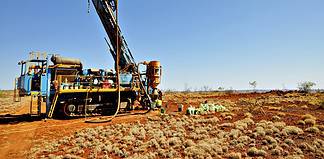LASERBOND is an Australian-based, Australian-founded and ASX-listed company specialising in surface engineering technology, manipulating surfaces to enhance their properties, to either repair them by cladding with a superior materials to the original components, or to extend the life of component by enhancing the material properties of the part.
In mining equipment, there are many wearing components that are production-critical. On very large equipment like drag lines, there are large shafts which can take up to a year to get made overseas and transported to Australia, costing hundreds of thousands of dollars, and while the majority of components may be serviceable, relatively small numbers of parts are worn and need to be repaired or replaced.
LaserBond National Sales and Marketing Manager David McCloskey said the company specialises in using lasers and thermal spray techniques to actually repair and improve those parts.
“For a mine site, if you have components that are wearing out prematurely, that are not getting to the next shutdown and that are expensive to replace with long lead times, LaserBond can repair those components at a fraction of the cost of replacing the full component – quite often to better than new,” Mr McCloskey said.
“Whether it’s a spline, a gear, a seal area or bearing journal, or an area that’s getting corrosion or abrasive-wear, we’re able to enhance those areas and ensure they are corrosion and or wear resistant.
“The technology of LaserBond® cladding rollers with a composite wear material is now being used in steel mills and is demonstrating up to a 20 times life advantage over a standard product. This technology is directly applicable to the repair and or surface engineering of many mining components that are subject to wear. We can dramatically increase the life of the wearing components because of the extreme abrasion resistance we have with this material.”
In terms of applications for mineral processing, Mr McCloskey said Laserbond has demonstrated a four times life advantage with dewatering screens and centrifuge baskets.
“We’ve partnered up with WearX for wear liners and previously they’d get around 3 million tonnes out of the deflector plates but now, because of the wear resistance of this material, they’re getting up to 24 million tonnes out of the plates,” he said.
“We also do a lot of components for off highway trucks and loaders with spindle repairs and suspension components where we use a combination of LaserBond® cladding or thermal metal spraying to repair those components.
“They are used in quite a few mine sites and several large component repairers use us including Caterpillar, WesTrac, Hastings Deering, Liebherr, and Sandvik just to name a few.”
LaserBond cladding
Large shafts on site can cost upwards of $200,000, and are often composed of special fatigue and crack-resistant materials that cannot be conventionally welded due to cracking that is formed in the heat affected zones.
Thermal spraying (which includes arc spray, plasma spray, and HVOF – high velocity oxy fuel applications) is one method of repairing some of these issue. However the mechanically bonded coating applied by thermal spraying may not be suitable for the loads and stresses it needs to resist. LaserBond laser cladding, provides a metallurgical bond and actually fuses the clad layer to the parent metal and is an efficient and cost-effective option.
“With the laser cladding, it’s such a finely focused energy source we play into the weld pool that’s created the powdered metal to build it back up, and because it melts and freezes almost instantaneously, we have very low distortion, very low dilution (low pulling iron out of the parent matter) and we have a very shallow heated affected zone, typically a fraction of a millimetre,” Mr McCloskey said.
“This is an advantage for a lot of components because we can LaserBond clad components that cannot be conventionally welded. In addition we have very minimal, if any, distortion.
“So we have a range of processes to apply all these different materials over the parent metal or metallurgically bond it to the parent metals, depending on the application. These processes can actually provide superior performance to the original part making it harder and more corrosion-resistant, which provides a longer service life.”
“While thermal spraying can be very wear-resistant, the coating can delaminate and come off with mechanical impact, but with laser cladding you can bash the crap out of it and it won’t come off –it can take a licking and keep on kicking,” Mr McCloskey said.
LaserBond deposition development
LaserBond developed a patented laser deposition process through research work led by founder and Executive Director Greg Hooper.
This enables high deposition rates of typically hard phase metallurgy, with minimal debilitating impact on the substrate and overlay.
“Our method enables the laser deposition of metallic or metal matrix composite (MMC) layers with a full metallurgical bond, by utilising an accurately focused, infinitely controllable, high-power laser beam supported in a multi-axis robot and integrated with a separate multi-axis work-piece platform that enables precise control of heat transfer into base material and the deposited layer,” Mr Hooper said.
“Our integration enables the repair of temperature sensitive components and materials, such as hardened shafts and gears, with minimal risk of distortion or other undesirable heat effects that undermine the integrity of the component or in-service performance.
“The concentration of hard phases can be significantly increased and dramatically improved distribution achieved with the new method, therefore wear resistance is considerably improved.”
The key advantages this deposition process offers over other methods are:
- High deposition rates
- Extremely low dilution with base material, enabling very thin layers
- Almost non-existent heat-affected zones, thereby no effect on structural performance of substrate
- Negligible distortion, enabling cladding of dimensionally sensitive components.


Resources industry technical engineering knowledge
Mr McCloskey emphasised three areas of LaserBond’s expertise within the resource industry.
“We know a lot about tribology … in particular, the mechanisms of wear in extreme mining, drilling, and mineral processing environments and their cost implications,” he said.
“The second key thing is advanced metallurgy. We’re very good at developing a cladding for a specific duty.
“Knowing our customer’s application and the wear characteristic occurring — say, in a slurry pump or percussion drill or inside a continuous underground miner — we tailor an alloy specifically for that.
“The third is our extensive understanding of the cladding application process—the ability to specify the right method and laser parameters.”
Technology licensing
The company now licences its laser cladding technologies as turnkey systems in tailored hardware, software and support packages.
The packages involve the design, building, installation and commissioning of a complete laser cladding cell tailored to a customer’s specific applications.
These systems incorporate fibre-coupled diode lasers in configurations from 4kW to 10kW. LaserBond has installed a 16kW unit in its advanced manufacturing and research facility in Adelaide.
Cladding head positioning is provided by a six-axis robot selected for high stability and control at extended reach. The company designs and manufactures its own multi-axis work piece positioning system, tailored for the customer’s application.
Internal systems have capacities for up to 20t components with a swing up to 2m and 9m in length.
Mr Hooper describes the proprietary powder injection nozzle system as a natural next step in development of the process.
“Cladding large mining industry components requires extended running times at high power levels, with some projects running 16 hours at maximum power,” he said.
“This requirement led us into developing our own water-cooled off-axis powder injection nozzle.
“This incorporates a rapidly replaceable powder injection tube and gas depressurised gravity fed powder mixer. The geometry of the part being processed determines parameter settings for the nozzle -this led us to invest in our own control system development.”
Future technology and innovation
In coming years, with further investment in its next generation advanced laser cladding technology cells, the company expects to be dealing with more OEM customers with greater cladding performance demands.
This will result in enhancing the performance of high-wear-critical metal components in a range of capital-intensive industries – particularly mining, where larger products and equipment constantly operate in a variety of highly abrasive and uncommon wear conditions during extraction and minerals processing.
LaserBond has technology licensing contracts with a large minerals-processing equipment manufacturing and repair company in Asia, and another large global original equipment manufacturer with facilities in the UK. These contracts involved design, building, installation, and commissioning of a laser cladding cells tailored to the company’s specific applications., and agreements for ongoing royalty payments.
“We chose companies that had demonstrated ability to partner with international technology companies, and which had a large presence in its mining equipment market,” Mr Hooper said.
“The contracts demonstrate the significant value in the technology and intellectual property that LaserBond has developed”
More information:
Phone: (02) 4631 4500
Email: [email protected]
Website: www.laserbond.com.au










































